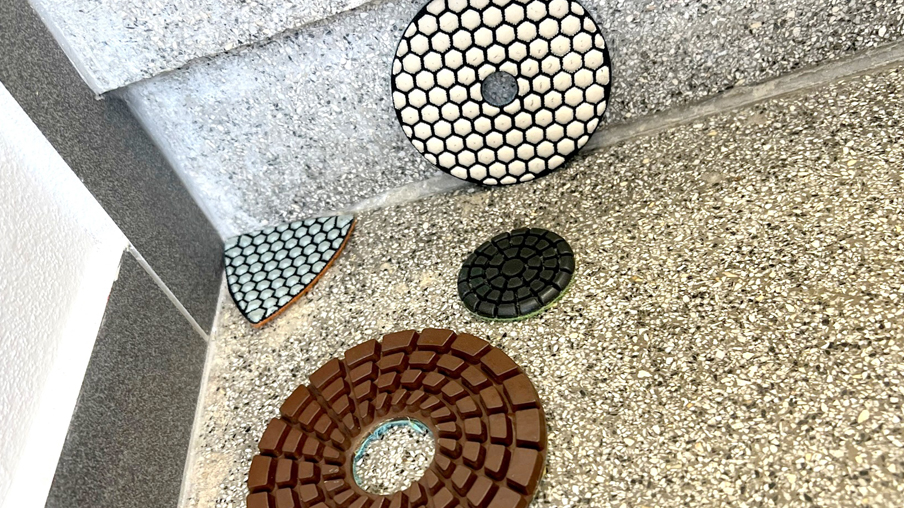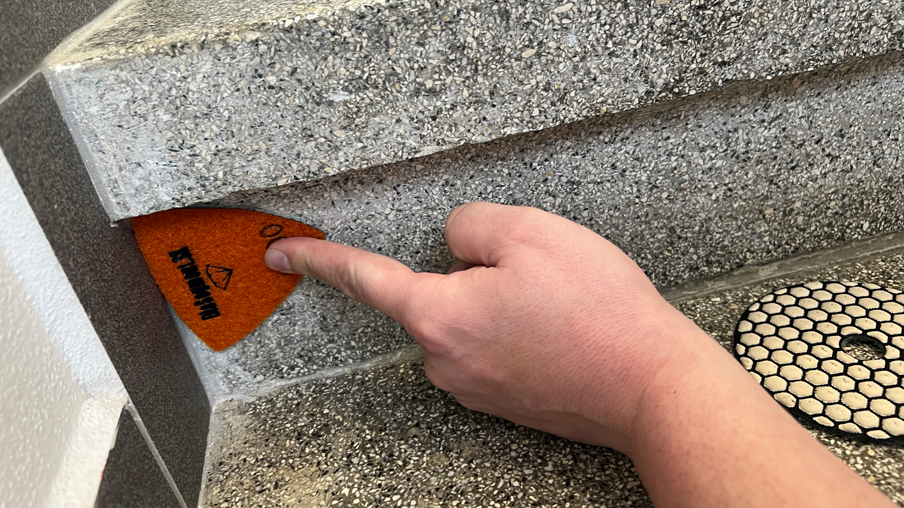You often turn to us for advice on how to proceed with the reconstruction of an old terrazzo staircase, corridor or polishing of classic or exposed concrete. Terrazzo, also called stoneware or artificial stone, is basically polished classic concrete with high-quality cement and marble rubble of a certain fraction. This material was extremely popular in the last century and its qualities are still appreciated today. With a certain amount of care in the form of sanding, polishing and protective coating, together we can give it a new look.
Surface preparation before sanding
Before starting the mechanical processing, it is important to properly prepare the surface of the material for the next steps. It is also important because, after careful preparation, the second phase - grinding with a finer tool - is often possible.
- Cleaning and removal of old coatings: Remove all dirt, dust, smog, grease, and remnants of building materials. You can use mechanical cleaning (for example, a scraper) or stone cleaning products from our offer.
- Repair of damage: If there are cracks or holes on the surface, repair them before processing with a suitable material (putty or cement mixture) and let it harden completely.
Grinding terrazzo, stoneware or concrete
Grinding is the first and key step in the process of polishing terrazzo or concrete. After thorough sanding, the surface must be flat, smooth, whole without defects and therefore ready for polishing:
- Machines: Since the first steps are an extremely dusty process, we recommend working with an angle grinder with suction and speed control. You can use the speed control in the polishing step.
- Tools: Hard concrete grinding wheels are suitable for this job. Choose the coarser grit #30 if you need to grind a larger amount of material. Grit #100 or 120 is used for finer sanding, smoothing scratches or sanding a thin layer.
- Technique: Sand the surface evenly and thoroughly over the entire surface, maintaining the same pressure. Try to get an absolute plane and make sure you don't miss any places. We covered the topic of stone and concrete grinding in more detail in this article.
- The result of the work: The material is light to white, has open capillaries and is therefore extremely absorbent. If you do not want to continue polishing, we recommend using a high-quality protective coating - impregnation.

Polishing of the ground surface
When the surface after sanding is flat without traces and scratches, you can proceed to the polishing process. In this step, the surface is gradually closed, the color and gloss of the material is highlighted.
- Machines: Large floor grinders, shoulder grinders are suitable, but for smaller projects, hand-held angle grinders and polishers with lower speeds or speed control are most often used.
- Tools: In our offer you will find several models of diamond polishing discs for polishing concrete or terrazzo. In most cases, we recommend flexible polishing pads for dry polishing intended for processing terrazzo and concrete, but tools designed for polishing granite are also suitable.
- Technique: Polish the surface evenly until you reach the desired shine. Use circular motions and make sure you don't miss any spots. If you are polishing dry, take care to properly cool the tool.
- The result of the work: The material is darker, the crushed stone in the mixture has a more pronounced color and shine. To preserve the appearance and at the same time protect against early deterioration, we recommend using a high-quality protective coating - impregnation.
Video: Polishing classic concrete with 3-step polishing discs for terrazzo and concrete.
Polishing corners
Corners, corners, hard-to-reach places and basically details are the biggest worries for masters. As can be seen in the photo below, the master did not pay too much attention to this detail. The biggest helpers in solving the details are:
- Diamond segment TRIANGLE, suitable for processing corners.
- The smallest polishing discs with a diameter of 50 or 80 millimeters.
- If it is necessary to polish in depth, you can insert an extension between the carrier of the polishing wheel and the tool.
- There are situations in which there is nothing left but manual work without machines. Here we can recommend polishing sponges or stone sandpaper.
Description of grain sizes suitable for grinding and polishing terrazzo and concrete
- Grinding phase: Grit #30 is used if surface realignment is required. If the surface is flat and not much material needs to be sanded, you can use #50,60. If you had to use #30, use #100 or #120 to smooth out the rough marks. In this case, hard metal grinding wheels for concrete or granite are used.
- Polishing phase: If the surface is smooth after sanding (after grit #120), you can start polishing with #400 and then #800. In accelerated procedures, these are #2 and #3 grits.
- High Gloss: Use #1500 or #3 grit for a nice gloss. If you want even more, you can use marble polishing pads (grit #3000 and up) or use polishing paste and work it with felt pads.

PHOTO: polishing tool TRIANGLE and detail on inconsistently machined places where traces of hreverse grinding.
Surface protection - protective coating (impregnation)
In order to ensure a long service life and a beautiful appearance of the surface, it is important to protect it. By choosing the right product, you will protect the reconstructed area both indoors and outdoors.
- Impregnation agent: Apply a protective coating that creates a protective layer and prevents the penetration of water and dirt. Choose a suitable impregnation responsibly. In our offer you will find vapor-permeable protective coatings with a strengthening effect or with a strong accentuation of the color. Both products are suitable for protecting concrete surfaces.
Maintenance: Regularly clean and maintain the surface with suitable products designed for this particular material. Acid cleaners are not suitable for polished terrazzo!
Use mild detergents and do not expose the surface to abrasive materials.
We strongly recommend consulting a trained technician for this activity. You can read more about this topic in this article.
Conclusion
Polishing terrazzo, concrete or exposed concrete can be a physically demanding process. But with the right tools, technique and patience, you can achieve a beautiful, shiny finish that will last for many years. Do not forget about regular maintenance and protection of the surface in order to enjoy its beauty for a long time.
